Related Research Articles

A robot is a machine—especially one programmable by a computer—capable of carrying out a complex series of actions automatically. A robot can be guided by an external control device, or the control may be embedded within. Robots may be constructed to evoke human form, but most robots are task-performing machines, designed with an emphasis on stark functionality, rather than expressive aesthetics.
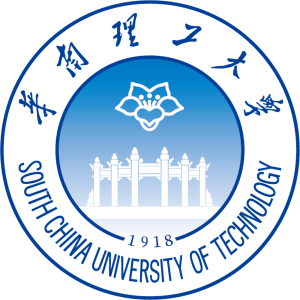
South China University of Technology is a major public research university in China. It is located in the Tianhe District and Panyu District of Guangzhou, capital of Guangdong Province, China. It is a multidisciplinary university focusing on engineering, combined with science, also promoting well coordinated development of management, economics, humanities and law. Its engineering ranks at 48th among world universities according to the Academic Ranking of World Universities (ARWU) in 2015. As of 2020, the U.S. News & World Report ranks South China University of Technology at 46th in engineering among Best Global Universities. It is a Chinese Ministry of Education Class A Double First Class University.

Tianjin University is the first modern higher education institution in China, and now a national university under the direct administration of the Ministry of Education of China. It is a Chinese Ministry of Education Class A Double First Class University. It was established in 1895 as Imperial Tientsin University and later Peiyang University. In 1951, after restructuring, it was renamed Tianjin University, and became one of the largest multidisciplinary engineering universities in China. The university was one of the first 16 universities accredited by the nation in 1959. It is also among the first group of institutions of higher learning in the both national "Project 211" and "Project 985" to which priority is given in construction. In order to carry out the "21st Century Education Revitalizing Action Plan", in late 2000 the Ministry of Education and Tianjin Municipality signed an agreement which aims to build Tianjin University into a 1st-class university in the world in the 21st century.

University of Shanghai for Science and Technology founded in 1906, is a public university in Shanghai, People's Republic of China. It is colloquially known as Shànghǎi Lǐgōng or Shànglǐ. With more than 110 years of history, USST has today become a comprehensive university, which now covers six main disciplines. USST is one of the three Key Universities "上海市重点大学" in Shanghai City, which has been receiving a high level of support from Shanghai Municipal Government. In July 2016, USST was selected as one of 25 universities which are jointly-sponsored and built by China's State Administration for Science, Technology and Industry for National Defence and provincial or municipal government.

The Indian Astronomical Observatory (IAO), located in Hanle near Leh in Ladakh, India, has one of the world's highest located sites for optical, infrared and gamma-ray telescopes. It is operated by the Indian Institute of Astrophysics, Bangalore. It is currently the ninth highest optical telescope in the world, situated at an elevation of 4,500 meters (14,764 ft).
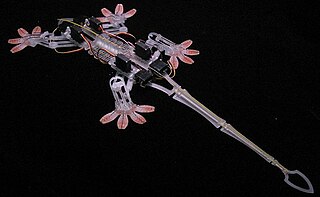
Synthetic setae emulate the setae found on the toes of a gecko and scientific research in this area is driven towards the development of dry adhesives. Geckos have no difficulty mastering vertical walls and are apparently capable of adhering themselves to just about any surface. The five-toed feet of a gecko are covered with elastic hairs called setae and the ends of these hairs are split into nanoscale structures called spatulae. The sheer abundance and proximity to the surface of these spatulae make it sufficient for van der Waals forces alone to provide the required adhesive strength. Following the discovery of the gecko's adhesion mechanism in 2002, which is based on van der Waals forces, biomimetic adhesives have become the topic of a major research effort. These developments are poised to yield families of novel adhesive materials with superior properties which are likely to find uses in industries ranging from defense and nanotechnology to healthcare and sport.
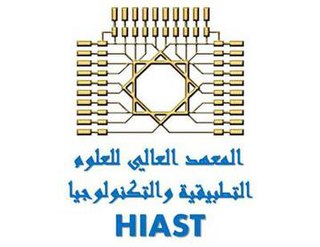
The Higher Institute for Applied Sciences and Technology (HIAST) is center of Excellence for Higher Education, Research & Development in Damascus, Syria.
Sumitomo Electric Industries, Ltd. is a manufacturer of electric wire and optical fiber cables. Its headquarters are in Chūō-ku, Osaka, Japan. The company's shares are listed in the first section of the Tokyo, Nagoya Stock Exchanges, and the Fukuoka Stock Exchange. In the period ending March 2021, the company reported consolidated sales of US$26,5 billion.
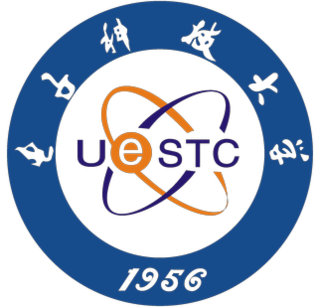
University of Electronic Science and Technology of China (UESTC) is a public technological university located in Chengdu, Sichuan, China. It is a Class A Double First Class University directly under the Ministry of Education. UESTC was included as one of the first universities into "Project 211" in 1997, and then the nation's “Project 985” in 2001.

Shaukat Hameed KhanPP, PhD, FPAS, is a Pakistani optical physicist and a visiting professor of physics at the Comsats University in Islamabad. Khan is known for his understanding in spark gap and plasma-induced Lasers in ionized environment.

Science and technology is a growing field in Pakistan and has played an important role in the country's development since its founding. Pakistan has a large pool of scientists, engineers, doctors, and technicians assuming an active role in science and technology. The real growth in science in Pakistan occurred after the establishment of the Higher education Commission in 2002 which supported science in a big way and also became the major sponsor of the Pakistan Academy of Sciences under the leadership of Prof. Atta-ur-Rahman. The emphasis was placed on quality rather than numbers during this period. The quality measures introduced by Prof. Atta-ur-Rahman as Founding Chairman HEC included:1) All Ph.D. thesis were evaluated by eminent foreign scientists,2) All PhD theses and research papers were checked for plagiarism 3) Some 11,000 students were sent abroad to leading universities for PhD level training and absorbed on their return, 4) Appointments at faculty positions were linked to international stature of the applicants as judged from their international publications, patents and citations, and (5) Quality Enhancement Cells were established in all universities for the first time in the history of the country. (6) The minimum criteria for establishment of a new university were approved by the Cabinet and universities that did not meet this criteria were closed down. (7) The Model University Ordinance was approved setting the governance parameters for new universities. (8) A list of fake higher education institutions was prepared and made public. (9) Quality Assurance Agency (QAA) was set up within the Higher Education Commission that established Quality Enhancement Cells (QECs) as its operational units in public and private-sector universities across the country. (10) The funding of universities was linked to excellence in teaching and research under a formula based funding mechanism that considered enrolment, subjects and quality of teaching and research. The first IT policy and implementation strategy was approved under the leadership of Prof. Atta-ur-Rahman, then Federal Minister of Science & technology, in August 2000 which laid the foundations of the development of this sector On the request of Prof. Atta-ur-Rahman, Intel initiated a nationwide programme to train school teachers in Information and Communication technologies in March 2002 which has led to the training of 220,000 school teachers in 70 districts and cities across Pakistan. A 15-year tax holiday was approved on the recommendation of Prof. Atta-ur-Rahman which has resulted in growth of IT business from $30 million in 2001 to over $3 billion. The Pakistan Austria University of Applied Engineering (Fachhochschule) has been established in Haripur Hazara under a Steering Committee Chaired by Prof. Atta-ur-Rahman in which students will get degrees from several Austrian universities. Pakistan's growth in scientific output can be seen from the fact that in 1990 Pakistan published 926 scholarly documents while in 2018 the number rose to 20548, a twenty times increase.In contrast India published 21443 scholarly documents in 1990 and the number rose to 171356 in 2018, an eight times increase. In 2018, 336 people per million were researchers in the R&D in Pakistan compared to 256 people per million being researchers in India. The reforms begun by Prof. Atta-ur-Rahman FRS in 2003-2008 have continued over the subsequent decade and according to the Web of Science report, there was a 300% growth in research publications in 2019 over the decade, with 2019 marking the first year in which Pakistan was ranked above the world average in research. In 2019, Pakistan produced 300% more publications indexed in the Web of Science Core Collection than in 2010. In the decade of 2010-2019, more than half of Pakistan’s research was published in journals with Impact Factor. The global influence of Pakistan’s research is increasing as scientists in the country are publishing more in top quartile journals. The Category Normalized Citation Impact of Pakistan’s publications has risen from 0.67 to 1.03. output. As of 2020, Pakistan has 85% teledensity with 183 million celllular, 98 million 3G/4G and 101 million broadband subscribers, due to the foundations laid by Prof. Atta-ur-Rahman of the IT and telecom industry during 2000-2008. In an analysis of scientific research productivity of Pakistan, in comparison to Brazil, Russia, India and China, Thomson Reuters has applauded the developments that have taken place as a result of the reforms introduced by Prof. Atta-ur-Rahman FRS, since Pakistan has emerged as the country with the highest increase in the percentage of highly cited papers in comparison to the "BRIC" countries
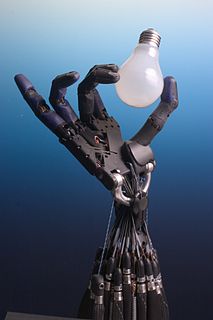
Robotics is an interdisciplinary field that integrates computer science and engineering. Robotics involves design, construction, operation, and use of robots. The goal of robotics is to design machines that can help and assist humans. Robotics integrates fields of mechanical engineering, electrical engineering, information engineering, mechatronics, electronics, bioengineering, computer engineering, control engineering, software engineering, mathematics, etc.
The Institute of Robotics and Intelligent Systems (IRIS) is part of the ETH Zurich, Switzerland. It replaced the existing Institute of Robotics, of the ETH Zurich in October 2002, when Prof. Bradley J. Nelson moved from the University of Minnesota, United States, to ETH Zurich and succeeded the Prof. Dr. Gerhard Schweitzer.

Margaret Ebunoluwa Aderin-Pocock is a British space scientist and science educator. She is an honorary research associate of University College London's Department of Physics and Astronomy. Since February 2014, she has co-presented the long-running astronomy television programme The Sky at Night with Chris Lintott. In 2020 she was awarded the Institute of Physics William Thomson, Lord Kelvin Medal and Prize for her public engagement in physics. She is the first African woman to win a gold medal in the Physics News Award. She has also earned the title of the president-elect of the British Science Association

Malek Ashtar University of Technology (MUT) is a public research university of engineering, science in Iran. Founded in 1984, MUT's main campus is located at Tehran, the capital of Iran. Its other campuses are located in Isfahan and Urmia. The university is named after Malik al-Ashtar, one of the most loyal companions of Ali Ibn Abi Talib.
Ch is a proprietary cross-platform C and C++ interpreter and scripting language environment, originally designed by Harry H. Cheng as a scripting language for beginners to learn mathematics, computing, numerical analysis, and programming in C/C++. Ch is now developed and marketed by SoftIntegration, Inc. A student edition is freely available. Ch Professional Edition for Raspberry Pi is free for non-commercial use.

Yutu was a robotic lunar rover that formed part of the Chinese Chang'e 3 mission to the Moon. It was launched at 17:30 UTC on 1 December 2013, and reached the Moon's surface on 14 December 2013. The mission marks the first soft landing on the Moon since 1976 and the first rover to operate there since the Soviet Lunokhod 2 ceased operations on 11 May 1973.

Ajay Kumar Sood is an Indian physicist, researcher and holder of 2 US and 5 Indian patents, known for his pioneering research findings on graphene and nanotechnology. He is a Distinguished Honorary Professor of Physics at Indian Institute of Science, Bangalore. The Government of India honoured him in 2013, with the Padma Shri, the fourth highest civilian award, for his contributions to the fields of science and technology. Sood was elected a Fellow of the Royal Society (FRS) in 2015. He has been on the Physical Sciences jury for the Infosys Prize from 2019.
Bradley James Nelson is an American roboticist and entrepreneur. He has been the Professor of Robotics and Intelligent Systems at ETH Zurich since 2002 and is known for his research in microrobotics, nanorobotics, and medical robotics. In 2005, he was chosen as one of Scientific American's top 50 leaders in science and technology for his work on practical applications of nanotubes. In 2019 he received the IEEE RAS Pioneer Award from the IEEE Robotics and Automation Society, "In recognition of outstanding contributions in micro and nano robotics". He is a co-founder of Aeon Scientific AG, Femtotools AG, OphthoRobotics AG, Magnes AG, Oxyle AG, and MagnebotiX AG.
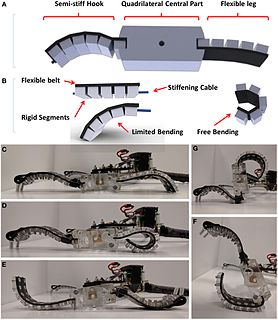
Soft robotics is the specific subfield of robotics dealing with constructing robots from highly compliant materials, similar to those found in living organisms.
References
- ↑ article on Baike website of Baidu, http://www.hudong.com/wiki/%E4%BB%BF%E7%94%9F%E6%9C%BA%E5%99%A8%E4%BA%BA%E5%A3%81%E8%99%8E